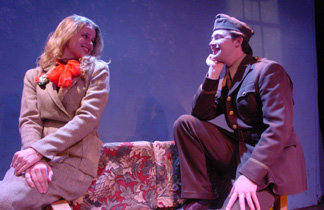All Aboard
'Last Train to Nibroc' a modest new entry in southern theatre tradition
By Rhonda Reeves

"Stellaaaaaaa. Stellllllllaaaaaaaaaaaaa."
Contrary to the opinions of many who reside above the Mason-Dixon line, not all southern drama is as overwrought as Tennessee Williams might lead us to believe.
Not that there's anything wrong with that.
But there are many sub-genres in contemporary southern theatre - some of which transcend regionalism and some of which don't. There's the syrupy, treacle of a Steel Magnolias or Crimes of the Heart. There's a sentimentally folksy Drivin' Miss Daisy. And once in a great while, there's a beautifully observed piece of quiet genius, like Marsha Norman's 'night, Mother.
Last Train to Nibroc, Actors' Guild's latest effort, is a little bit of all of the above. Structurally, it probably shares the most with the latter - one act, one set, two characters - one of whom is an epileptic, given to "fits," as they are described. But the similarities end there. Nibroc is more broad and sentimental - not as spare and ascetic as Norman's work. It's also a romance.
Two characters meet on a train, and the play follows them in three scenes, over the course of the next couple years.
Director Maureen Daly has cast two fresh faces, "with a handful of experience, primarily in academic theatre" in the roles of Raleigh (Michael Pafunda) and May (Rachel Rogers).
It was a conscious decision on her part, she says, citing playwright Arlene Hutton's description of the characters as being "in their very early 20s."
She adds, "It's a very important element in terms of who these people were. As we get a little older, we have a variety of life expectations that we don't have when we're that young... you lose that little sense of innocence, that 'freshness' that's so instrumental in the play."
Of the play's "roots," centered around Corbin, Kentucky and the Nibroc festival, she says, "It seems to me that the characters have so much to do with Nibroc and Corbin - not so much the place - as they are a product of that kind of town," describing them as "fresh-faced young and innocent coming from a wonderful little town like Corbin, not something you would find in characters from Los Angeles or Chicago."
She's pleased to work "with a production that is so specifically character-driven - [it's a] product of a very specific place - but ultimately it really is about the people, which is why it's only a bench" (which serves as the set through all three scenes).
Indeed, there's nothing in the writing that uniquely suggests Kentucky as the characters' origins - they could virtually be from anywhere in the rural or smalltown south.
Which might explain May's deep southern drawl at the dress rehearsal. Asked if it wasn't a little heavy on the Blanche DuBois, Daly laughs and says she thinks that bug's been worked out in subsequent rehearsals.
The actual dialect and rhythms of southeastern Kentucky are those of the mountain south, and they bear no resemblance to a Virginia lilt or Mississippi drawl - but that's a difficult accent to represent on stage, Daly acknowledges.
"We fought from the first day not to make a show of stereotypical southerner, and the accent plays into that so quickly. As soon as people hear that 'hick' or 'hillbilly' accent, they're done. And what this play is about doesn't need to have to fight that," adding that it's a lovely little romantic piece... about two people who find each other."
Of the play's idioms, like "don't make no nevermind to me," she said that Rogers was inquisitive over the double, or triple negative. (Worse than that, it shows up twice, and it's a line that would seem more at home in Gone With the Wind than any drama from this century.)
More importantly, Daly resisted stereotypes at every opportunity, such as the instruction to put Raleigh in bib overalls at the Nibroc festival. Someone on the crew had family in Corbin and confirmed Daly's impression that a festival would've been a dressup occasion - and that overalls were largely confined to the farm.
The director ultimately describes the play as "a lovely opportunity to see minds and hearts at work," adding, "one thing I love about southern tradition is that it's about stories. And that's what theatre is: storytelling."
The Last Train to Nibroc will run Thursdays-Saturdays at 8 p.m. through December 24 (Sundays at 2) at Actors Guild of Lexington, 139 W. Short Street. Tickets, 233-0663.
A woman and a man meet on a train in December 1940.
Raleigh (Michael Pafunda) is a soldier on a medical deferment, who wants to be a writer in New York (he wanted a seat on this train because it holds the bodies of Nathaniel West and F. Scott Fitzgerald). May (Rachel Rogers) has been visiting her (now ex) fiancé in California, and is headed home to Kentucky.
She's from the small town of Corbin; he's from Woodbine (a place, too small to have ever been called a town).
He says he'll take her to Corbin's locally-renowned Nibroc Festival when they meet again. (Only natives will notice the historical inaccuracy that the Nibroc didn't crown its first queen until the 1950s.) Later, he tells May he's sold a story to the Courier-Journal (though it didn't become the Courier-Journal till the 60s).
Though the play is characterized as a one-act, the two of them re-connect in two more "scenes" that take place over the course of the next few years following their initial meeting.
BIO
Arlene Hutton, playwright, is the pseudonym for Beth Lincks, actress.
Hutton's parents are from Corbin, Kentucky, but though she was born and raised in the south, she did not live in Kentucky.
Last Train to Nibroc opened in New York in 1999.